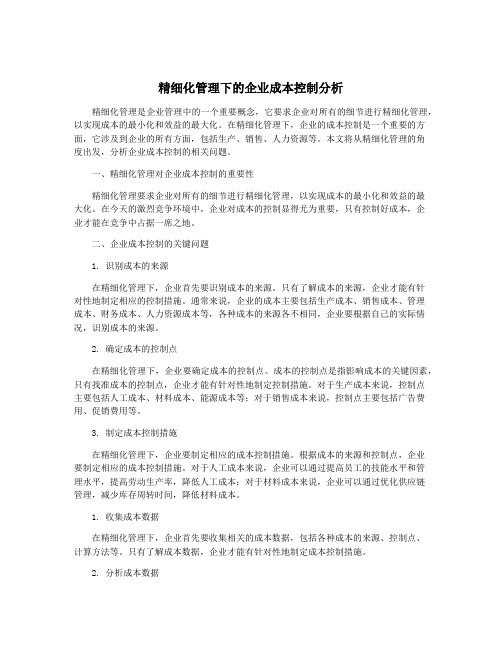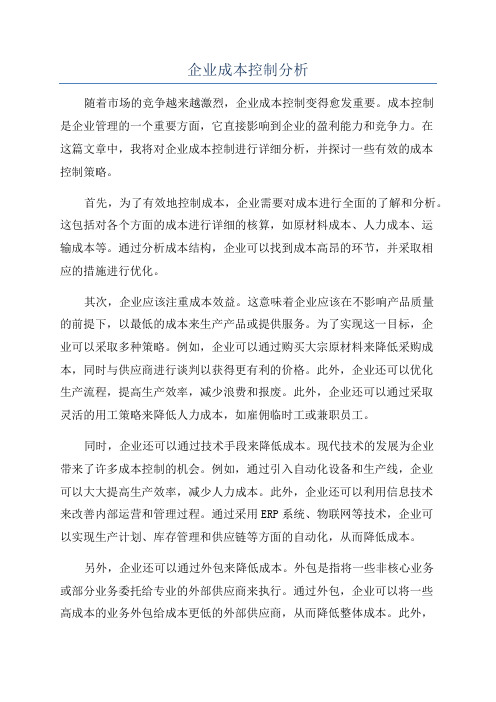企业成本控制分析
成本控制数据分析

成本控制数据分析在企业运营过程中,成本控制是一个至关重要的环节。
通过对成本相关数据进行分析,企业可以全面了解成本构成和变动,进而制定出有效的成本控制策略。
本文将着重介绍成本控制数据分析的重要性和一些常用的分析方法。
一、成本控制数据分析的重要性成本控制数据分析是帮助企业实现高效运作的基础,它能够为企业提供有价值的信息和决策支持。
具体来说,它的重要性体现在以下几个方面:1.了解成本构成:通过数据分析,企业可以准确地了解到每个成本项的构成,并且可以识别出在运营过程中哪些环节占据了主要的成本比例,从而有针对性地进行成本控制。
2.发现成本变动原因:成本是会随着外界环境和内部因素而变动的,成本控制数据分析可以帮助企业追踪和分析成本变动的原因,从而及时调整经营策略和采取相应的措施。
3.提高决策质量:成本控制数据分析提供的信息和洞察可以帮助企业在决策过程中更加准确地估算和评估成本,并且可以帮助企业管理层进行科学决策,降低决策风险。
二、常用的成本控制数据分析方法在使用数据分析来进行成本控制时,有多种方法可供选择,下面将介绍一些常用且有效的方法:1.差异分析:差异分析是通过比较实际成本与预算成本之间的差异来分析成本的波动原因。
通过比较差异的大小和原因,企业可以找出导致成本偏离预算的原因,并且针对性地制定控制计划。
2.趋势分析:趋势分析是通过分析成本的历史数据,找出成本的变动趋势,并对未来的成本进行预测。
这种方法可以帮助企业提前做好应对措施,防范潜在的风险。
3.成本效益分析:成本效益分析是通过比较成本与效益之间的关系,评估企业的投资决策是否合理。
通过此种方法,企业可以判断在成本控制下,投资带来的效益是否与预期相符,并根据评估结果做出相应调整。
4.目标成本管理:目标成本管理是一种根据市场需求和竞争情况,为产品或服务设定目标价格,并从中倒退计算出目标成本的方法。
通过这种方法,企业可以在产品设计和生产阶段就充分考虑成本约束,降低可能发生的成本超支。
精细化管理下的企业成本控制分析

精细化管理下的企业成本控制分析精细化管理是指企业在日常经营中采取一系列措施,通过精细的数据分析和管理手段,来提高企业的运营效率和降低成本。
企业成本控制是精细化管理的重要组成部分,它涉及到企业各个层面和环节的成本管理和控制。
下面分析精细化管理下的企业成本控制的几个关键点。
首先是成本分类和分析。
企业需要将成本分类,将各项成本按照不同的属性进行划分和归类,如直接成本和间接成本、可变成本和固定成本等。
然后对各项成本进行详细分析,找出成本的构成和变动原因,从而更好地控制成本。
其次是成本预算和控制。
企业需要根据历史数据和市场情况制定成本预算,将成本控制在可接受的范围内。
企业需要建立相应的成本控制机制,设定相应的成本控制指标和责任人,及时监测和调整成本的执行情况。
再次是成本效益分析。
企业应该通过成本效益分析,评估企业的投入和产出效果,确定成本的合理性和效益性。
通过分析成本效益,企业可以更好地理解成本与业绩之间的关系,并在管理中做出相应的调整和决策。
最后是技术创新和成本降低。
在精细化管理下,企业应该注重技术创新和成本降低。
通过引进新技术和设备,提高生产效率和质量,降低生产成本。
企业应该注重流程优化和精益化管理,通过减少浪费和提高效率,降低管理成本。
在精细化管理下,企业成本控制是企业管理的一个重要环节。
只有通过精细的成本管理和控制,企业才能实现高效运营和可持续发展。
通过成本分类与分析、成本预算与控制、成本效益分析以及技术创新与成本降低等措施,企业可以更好地理解和控制成本,提高业务竞争力。
企业如何进行成本控制与分析

企业如何进行成本控制与分析在现代商业竞争激烈的环境中,企业要保持长期稳定的发展,必须注重成本控制与分析。
成本控制是指企业通过制定合理的成本预算、进行成本核算和采取相应的管理措施,以达到降低成本、提高效益的目标。
而成本分析则是通过对成本的细致分析,找出成本结构、成本来源以及成本变动的主要原因,为企业的经营决策提供依据。
下面将介绍企业如何进行成本控制与分析的方法和步骤。
一、成本控制的方法和步骤1. 制定合理的成本预算成本预算是成本控制的基础,企业应该根据历史数据和市场需求等因素,制定合理的成本预算。
成本预算不仅包括直接成本和间接成本,还包括固定成本和可变成本。
通过合理的成本预算,企业可以把握成本的总体状况,避免因成本超支而导致企业经营困难。
2. 进行成本核算成本核算是对企业各项成本进行详细记录和计算的过程,通过成本核算可以了解企业各项成本的来源和组成,并为成本分析提供可靠的数据基础。
企业可以采用标准成本法、实际成本法等方法进行成本核算,确保成本核算的准确性和及时性。
3. 设定成本控制指标根据企业的实际情况,设定相应的成本控制指标。
成本控制指标可以包括成本产值比、人力密度、设备利用率等多个方面,通过合理的指标设定,企业可以更加有效地控制成本,提高生产效率。
4. 采取成本控制措施根据成本控制指标的要求,采取相应的成本控制措施。
例如,对于较高的人力密度,企业可以通过增加工作岗位或提高员工的技能水平来分散人力;对于低效的设备利用率,企业可以进行设备更新或进行定期维护,提高设备的使用效率。
二、成本分析的方法和步骤1. 分析成本结构成本结构分析是指对企业各项成本的构成和比例进行分析,以找出成本的主要来源和组成。
企业可以通过继续教育培训、引入先进技术等方式来降低人工成本;通过优化供应链、采取集中采购等方式来降低原材料成本;通过改进生产工艺、提高生产效率等方式来降低制造成本。
2. 分析成本变动原因成本变动分析是指对成本变动的原因进行分析,以找出成本变动背后的主要原因。
2024年浅析企业的成本控制

2024年浅析企业的成本控制一、成本控制的定义成本控制,顾名思义,是对企业生产经营过程中各项成本进行有效管理和控制的一系列活动。
它涉及到产品从设计、生产到销售的每一个环节,目的是确保成本在预算范围内,同时实现企业的盈利目标。
成本控制不仅仅是对直接材料、直接人工和制造费用的控制,还包括间接费用、管理费用、销售费用等各方面的成本控制。
二、成本控制的重要性成本控制对企业而言至关重要,主要体现在以下几个方面:提高盈利能力:成本控制有助于减少不必要的开支,增加企业的净利润。
增强竞争力:成本控制能够帮助企业以更低的成本生产相同质量的产品,从而在市场上获得更大的竞争优势。
指导企业决策:通过成本分析和控制,企业可以更好地了解各项费用的构成,为管理层提供决策支持。
资源配置优化:成本控制能够促进企业资源的合理分配和使用,避免资源的浪费。
三、成本控制的主要内容成本控制的主要内容包括以下几个方面:材料成本控制:对原材料、辅助材料等采购成本进行有效控制,确保采购价格合理、质量稳定。
人工成本控制:通过合理的薪酬制度和激励机制,控制人工成本在合理范围内。
制造费用控制:对生产过程中的各项费用进行严格把关,包括水电费、折旧费等。
间接费用控制:对管理费用、销售费用等间接费用进行合理预算和控制。
四、成本控制的方法与策略为实现有效的成本控制,企业可以采取以下方法和策略:目标成本管理:设定明确的成本目标,通过预算、核算、分析等手段确保成本目标的实现。
作业成本法:通过对生产过程中的作业进行分析,找出成本动因,进而控制成本。
价值链分析:通过分析企业的价值链,找出增值环节和非增值环节,优化成本结构。
持续改进:通过持续改进生产流程、提高生产效率等方式降低成本。
跨部门合作:加强部门间的沟通与协作,共同推动成本控制工作。
五、成本控制的挑战与对策在成本控制过程中,企业可能会面临一些挑战,如原材料价格波动、人工成本上涨、市场需求变化等。
为应对这些挑战,企业可以采取以下对策:建立灵活的成本控制机制:根据市场变化及时调整成本控制策略,确保成本控制的有效性。
成本控制数据分析报告

成本控制数据分析报告1. 引言成本控制是企业管理中重要的一环,通过对成本进行有效的分析和管理,可以帮助企业实现利润最大化。
本报告旨在通过对某公司成本控制数据的分析,提供准确的数据支持和建议,以优化成本管理策略。
2. 成本结构分析2.1 直接成本直接成本是企业在产品或服务生产过程中与具体产品或服务直接相关的成本,主要包括原材料、直接劳动力成本等。
通过对直接成本的分析,可以确定成本占比,帮助企业确定成本重点控制的方向。
2.2 间接成本间接成本是企业在生产过程中与具体产品或服务间接相关的成本,包括管理费用、销售费用等。
通过对间接成本的分析,可以了解各项费用的构成,从而找出成本效益较低的环节,减少不必要的费用支出。
3. 成本变动情况分析通过对成本的变动情况进行分析,可以了解成本的变化趋势及其原因,为成本控制提供依据。
4. 成本效益分析4.1 边际成本分析边际成本是指企业增加或减少一个单位产量所需增加或减少的成本,通过边际成本分析,可以确定一个合理的产量水平,避免过量或不足产量导致的成本浪费。
4.2 投资回收期分析通过计算投资回收期,可以了解投资项目的收回时间,判断项目的投资回报率,避免长期的投资项目对成本控制产生不良影响。
5. 成本控制策略及建议5.1 优化采购策略通过选择合适的供应商,与供应商进行有效的谈判和合作,可以降低原材料的采购成本,提高利润空间。
5.2 提高生产效率加强生产线的管理,优化工艺流程,提高设备利用率和劳动力效率,可以减少生产成本,提高产品质量。
5.3 控制非必要费用对于各项间接成本,进行分析和评估,削减不必要的管理费用和销售费用,提高企业的竞争力。
6. 结论通过对成本控制数据的分析,可以看出某公司在成本控制方面还存在一些可以改进的地方。
在优化采购策略、提高生产效率和控制非必要费用等方面,可以采取相关的措施,进一步提高成本控制水平,实现企业的长期可持续发展目标。
7. 参考文献 (若有)注:本报告采用了正式报告的格式和结构,以便清晰地呈现分析结果和建议。
企业成本控制问题分析

企业成本控制问题分析企业成本控制是企业管理的一个重要内容,影响着企业的盈利能力和竞争力。
在当前经济形势下,成本控制问题更加凸显,企业必须认真分析和解决成本控制问题,以确保企业的稳健发展。
本文将从成本控制的意义和方法、成本控制存在的问题以及有效的成本控制措施等方面进行分析,并提出一些建议。
一、成本控制的意义和方法成本控制是企业管理的基本工作之一,通过不断优化和精简企业的生产和经营过程,降低企业生产、经营和管理的成本,提高企业经济效益。
成本控制的意义在于:1. 提高企业盈利能力:成本是企业盈利的基础,通过控制成本可以提高企业的盈利能力,增加企业的竞争优势。
2. 优化资源配置:有效的成本控制可以使企业资源得到合理利用,提高资源利用率,减少浪费,降低企业经营成本。
3. 提高企业的生产效率:成本控制可以促使企业对生产过程进行优化,提高生产效率,提高产品质量,从而提高企业的市场竞争力。
成本控制的方法主要包括:1. 精简管理层次:精简企业管理层次可以降低企业的管理费用,提高管理效率。
2. 优化生产工艺和流程:对生产流程进行优化可以提高生产效率,降低生产成本。
3. 控制采购成本:通过谈判、竞价等方式降低原材料采购成本。
4. 提高员工的劳动生产率:通过培训和激励,提高员工的劳动生产率,降低人工成本。
5. 进行成本核算和分析:通过成本核算和分析,了解企业各项成本的构成和分布,找出成本控制的重点和方向。
二、成本控制存在的问题在实际运营过程中,企业面临着一些成本控制存在的问题:1. 管理层对成本控制重视不够:有些企业管理层对成本控制的重视程度不够,缺乏有效的成本控制措施,导致成本费用过高,影响了企业的盈利能力。
2. 成本核算不准确:有些企业对成本的核算方式不够科学严谨,导致成本核算结果不准确,影响了成本控制的效果。
3. 员工的成本意识不强:有些员工对成本的重要性认识不足,缺乏成本意识,导致部分成本无法有效控制。
4. 采购成本高企:由于企业没有建立健全的供应链管理体系,导致采购成本偏高,影响了企业的盈利能力。
精细化管理下的企业成本控制分析

精细化管理下的企业成本控制分析精细化管理是企业管理中的一个重要概念,它要求企业对所有的细节进行精细化管理,以实现成本的最小化和效益的最大化。
在精细化管理下,企业的成本控制是一个重要的方面,它涉及到企业的所有方面,包括生产、销售、人力资源等。
本文将从精细化管理的角度出发,分析企业成本控制的相关问题。
一、精细化管理对企业成本控制的重要性精细化管理要求企业对所有的细节进行精细化管理,以实现成本的最小化和效益的最大化。
在今天的激烈竞争环境中,企业对成本的控制显得尤为重要,只有控制好成本,企业才能在竞争中占据一席之地。
二、企业成本控制的关键问题1. 识别成本的来源在精细化管理下,企业首先要识别成本的来源。
只有了解成本的来源,企业才能有针对性地制定相应的控制措施。
通常来说,企业的成本主要包括生产成本、销售成本、管理成本、财务成本、人力资源成本等,各种成本的来源各不相同,企业要根据自己的实际情况,识别成本的来源。
2. 确定成本的控制点在精细化管理下,企业要确定成本的控制点。
成本的控制点是指影响成本的关键因素,只有找准成本的控制点,企业才能有针对性地制定控制措施。
对于生产成本来说,控制点主要包括人工成本、材料成本、能源成本等;对于销售成本来说,控制点主要包括广告费用、促销费用等。
3. 制定成本控制措施在精细化管理下,企业要制定相应的成本控制措施。
根据成本的来源和控制点,企业要制定相应的成本控制措施。
对于人工成本来说,企业可以通过提高员工的技能水平和管理水平,提高劳动生产率,降低人工成本;对于材料成本来说,企业可以通过优化供应链管理,减少库存周转时间,降低材料成本。
1. 收集成本数据在精细化管理下,企业首先要收集相关的成本数据,包括各种成本的来源、控制点、计算方法等。
只有了解成本数据,企业才能有针对性地制定成本控制措施。
2. 分析成本数据收集成本数据后,企业要对成本数据进行详细的分析,找出成本的来源和控制点。
企业可以通过成本分析的方法,找出成本的构成和规律性变化,为制定成本控制措施提供依据。
企业成本控制分析

企业成本控制分析随着市场的竞争越来越激烈,企业成本控制变得愈发重要。
成本控制是企业管理的一个重要方面,它直接影响到企业的盈利能力和竞争力。
在这篇文章中,我将对企业成本控制进行详细分析,并探讨一些有效的成本控制策略。
首先,为了有效地控制成本,企业需要对成本进行全面的了解和分析。
这包括对各个方面的成本进行详细的核算,如原材料成本、人力成本、运输成本等。
通过分析成本结构,企业可以找到成本高昂的环节,并采取相应的措施进行优化。
其次,企业应该注重成本效益。
这意味着企业应该在不影响产品质量的前提下,以最低的成本来生产产品或提供服务。
为了实现这一目标,企业可以采取多种策略。
例如,企业可以通过购买大宗原材料来降低采购成本,同时与供应商进行谈判以获得更有利的价格。
此外,企业还可以优化生产流程,提高生产效率,减少浪费和报废。
此外,企业还可以通过采取灵活的用工策略来降低人力成本,如雇佣临时工或兼职员工。
同时,企业还可以通过技术手段来降低成本。
现代技术的发展为企业带来了许多成本控制的机会。
例如,通过引入自动化设备和生产线,企业可以大大提高生产效率,减少人力成本。
此外,企业还可以利用信息技术来改善内部运营和管理过程。
通过采用ERP系统、物联网等技术,企业可以实现生产计划、库存管理和供应链等方面的自动化,从而降低成本。
另外,企业还可以通过外包来降低成本。
外包是指将一些非核心业务或部分业务委托给专业的外部供应商来执行。
通过外包,企业可以将一些高成本的业务外包给成本更低的外部供应商,从而降低整体成本。
此外,企业还可以通过与供应商和合作伙伴建立长期合作关系来降低成本。
通过与供应商进行战略合作,企业可以获得更好的价格和服务,并且可以共同开发新的产品或解决方案。
最后,企业应该注重成本管理和监控。
成本控制并不是一次性的工作,而是一个持续的过程。
企业应该建立完善的成本管理和监控机制。
这包括建立成本核算体系、制定成本控制指标、建立成本预算等。
- 1、下载文档前请自行甄别文档内容的完整性,平台不提供额外的编辑、内容补充、找答案等附加服务。
- 2、"仅部分预览"的文档,不可在线预览部分如存在完整性等问题,可反馈申请退款(可完整预览的文档不适用该条件!)。
- 3、如文档侵犯您的权益,请联系客服反馈,我们会尽快为您处理(人工客服工作时间:9:00-18:30)。
COST CONTROLRoger J. AbiNaderReference for Business,Encyclopedia of Business, 2nd ed.Cost control, also known as cost management or cost containment, is a broad set of cost accountingmethods and management techniques with the common goal of improving business cost-efficiency by reducing costs, or at least restricting their rate of growth. Businesses use cost control methods to monitor, evaluate, and ultimately enhance the efficiency of specific areas, such as departments, divisions, or product lines, within their operations.During the 1990s cost control initiatives received paramount attention from corporate America. Often taking the form of corporate restructuring, divestmentof peripheral activities, mass layoffs,or outsourcing,cost control strategies were seen as necessary to preserve—or boost—corporate profits and to maintain—or gain—a competitive advantage. The objective was often to be the low-cost producer in a given industry, which would typically allow the company to take a greater profit per unit of sales than its competitors at a given price level.Some cost control proponents believe that such strategic cost-cutting must be planned carefully, as not all cost reduction techniques yield the same benefits. In a notable late 1990s example, chief executive Albert J. Dunlap, nicknamed "Chainsaw Al" because of his penchant for deep cost cutting at the companies he headed, failed to restore the ailing small appliance maker Sunbeam Corporation to profitability despite his drastic cost reduction tactics. Dunlap laid off thousands of workers and sold off business units, but made little contribution to Sunbeam's competitive position or share price in his two years as CEO. Consequently, in 1998 Sunbeam's board fired Dunlap, having lost confidence in his "one-trick" approach to management.Behavioral management deals with the attitudes and actions of employees. While employee behavior ultimately impacts on success, behavioral management involves certain issues and assumptions not applicable to accounting's control function. On the other hand, performance evaluation measures outcomes of employee's actions by comparing the actual results of business outcomes to predetermined standards of success. In this way management identifies the strengths it needs to maximize, and the weaknesses it seeks to rectify. This process of evaluation and remedy is called cost control.Cost control is a continuous process that begins with the proposed annual budget. The budget helps: (1) to organize and coordinate production, and the selling, distribution, service, and administrative functions; and (2) to take maximum advantage of available opportunities. As the fiscal year progresses, management compares actual results with those projected in the budget and incorporates into the new plan the lessons learned from its evaluation of current operations.Control refers to management's effort to influence the actions of individuals who are responsible for performing tasks, incurring costs, and generating revenues. Management is a two-phased process: planningrefers to the way that management plans and wants people to perform, while controlrefers to the procedures employed to determine whether actual performance complies with these plans. Through the budget process and accounting control, management establishes overall company objectives, defines the centers of responsibility, determines specific objectives for each responsibility center, and designs procedures and standards for reporting and evaluation.A budget segments the business into its components or centers where the responsible party initiates and controls action. Responsibility centersrepresent applicable organizational units, functions, departments, and divisions. Generally a single individual heads the responsibility center exercising substantial, if not complete, control over the activities of people or processes within the center and controlling the results of their activity. Cost centersare accountable only for expenses, that is, they do not generate revenue. Examples include accounting departments, human resources departments, and similar areas of the business that provide internal services. Profit centersaccept responsibility for both revenue and expenses. For example, a product line or an autonomous business unit might be considered profit centers. If the profit center has its own assets, it may also be considered an investment center,for which returns on investment can be determined. The use of responsibility centers allows management to design control reports to pinpoint accountability, thus aiding in profit planning.A budget also sets standards to indicate the level of activity expected from each responsible person or decision unit, and the amount of resources that a responsible party should use in achieving that level of activity. A budget establishes the responsibility center, delegates the concomitant responsibilities, and determines the decision points within an organization.The planning process provides for two types of control mechanisms:Feedforward: providing a basis for control at the point of action (the decision point); andFeedback: providing a basis for measuring the effectiveness of control after implementation.Management's role is to feedforwarda futuristic vision of where the company is going and how it is to get there, and to make clear decisions coordinating and directing employee activities. Management also oversees the development of procedures to collect, record, and evaluate feedback.Therefore, effective management controls results from leading people by force of personality and through persuasion; providing and maintaining proper training, planning, and resources; and improving quality and results through evaluation and feedback.Control reports are informational reports that tell management about an entity's activities. Management requests control reports only for internal use, and, therefore, directs the accountingdepartment to develop tailor-made reporting formats. Accounting provides management with a format designed to detect variations that need investigating. In addition, management also refers to conventional reports such as the income statement and funds statement, and external reports on the general economy and the specific industry.Control reports, then, need to provide an adequate amount of information so that management may determine the reasons for any cost variances from the original budget. A good control report highlights significant information by focusing management's attention on those items in which actual performance significantly differs from the standard.Because key success factors shift in type and number, accounting revises control reports when necessary. Accounting also varies the control period covered by the control report to encompass a period in which management can take useful remedial action. In addition, accounting disseminates control reports in a timely fashion to give management adequate time to act before the issuance of the next report.Managers perform effectively when they attain the goals and objectives set by the budget. With respect to profits, managers succeed by the degree to which revenues continually exceed expenses. In applying the following simple formula, managers, especially those in operations, realize that they exercise more control over expenses than they do over revenue.While they cannot predict the timing and volume of actual sales, they can determine the utilization rate of most of their resources, that is, they can influence the cost side. Hence, the evaluation of management's performance and its operations is cost control.For cost control purposes, a budget provides standard costs. As management constructs budgets, it lays out a road map to guide its efforts. It states a number of assumptions about the relationships and interaction among the economy, market dynamics, the abilities of its sales force, and its capacity to provide the proper quantity and quality of products demanded.Accounting plays a key role in all planning and control. It does this in four key areas: (1) data collection, (2) data analysis, (3) budget control and administration, and (4) consolidation and review.The accountants play a key role in designing and securing support for the procedural aspects of the planning process. In addition, they design and distribute forms for the collection and booking of detailed data on all aspects of the business.Although operating managers have the main responsibility of planning, accounting compiles and coordinates the elements. Accountants subject proposed budgets to feasibility and profitability analyses to determine conformity to accepted standards and practices.Management relies on such accounting data and analysis to choose from several cost control alternatives, or management may direct accounting to prepare reports specifically for evaluatingsuch options. As the Chainsaw Al episode indicated, all costs may not be viable targets for cost-cutting measures. For instance, in mass layoffs, the company may lose a significant share of its human capitalby releasing veteran employees who are experts in their fields, not to mention by creating a decline in morale among those who remain. Thus management must identify which costs have strategic significance and which do not.To determine the strategic impact of cost-cutting, management has to weigh the net effects of the proposed change on all areas of the business. For example, reducing variable costs related directly to manufacturing a product, such as materials and transportation costs, could be the key to greater incremental profits. However, management must also consider whether saving money on production is jeopardizing other strategic interests like quality or time to market. If a cheaper material or transportation system negatively impacts other strategic variables, the nominal cost savings may not benefit the company in the bigger picture, e.g., it may lose sales. In such scenarios, managers require the discipline not to place short-term savings over long-term interests.One trend in cost control has been toward narrowing the focus of corporate responsibility centers, and thereby shifting some of the cost control function to day-to-day managers who have the most knowledge of and influence over how their areas spend money. This practice is intended to promote bottom-up cost control measures and encourage a widespread consensus over cost management strategies.Control of the business entity, then, is essentially a managerial and supervisory function. Control consists of those actions necessary to assure that the entity's resources and operations are focused on attaining established objectives, goals and plans. Control, exercised continuously, flags potential problems so that crises may be prevented. It also standardizes the quality and quantity of output, and provides managers with objective information about employee performance. Management compares actual performance to predetermined standards and takes action when necessary to correct variances from the standards.。
